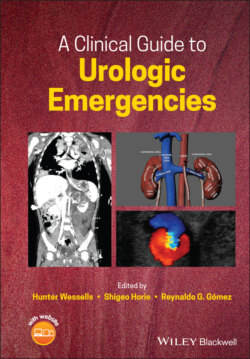Читать книгу A Clinical Guide to Urologic Emergencies - Группа авторов - Страница 38
Pathophysiology of Penetrating Trauma
ОглавлениеLow‐velocity weapons, such as knives, lead to local tissue damage and effects along the tract of penetration. High‐velocity projectiles, such as bullets and shrapnel, result in wider tissue injury. This is governed by the formula KE = ½ MV2, where KE is kinetic energy, M is the bullet mass, and V is the velocity. On average, a rifle (such as the AK‐47 or M‐16A1) has a bullet velocity 2–3 times greater than a standard handgun. This translates into 4–9 times greater kinetic energy (holding mass constant), thus causing greater damage. There are two areas of projectile‐tissue interaction in missile wounds – the permanent and temporary cavity. The permanent cavity is due to local tissue damage and necrosis due to the projectile, whereas the temporary cavity is caused by the transient lateral displacement of tissue [16]. Due to varying bullet characteristics, such as fragmentation, weight, and yaw patterns, bullets can cause variable and significant damage in the temporary cavity that may seem out of proportion to the entry or exit wound.
Injury from explosions are classified into: (i) primary BI due to the interaction of the blast wave with gas‐filled structures; (ii) secondary BI due to ballistic trauma resulting from fragmentation wounds from the explosive device or the environment; (iii) tertiary BI due to displacement of the victim or environmental structures, which are largely blunt injuries; and (iv) quaternary BI or burns, toxins, and radiation contamination [17]. Most primary BI do not result in surviving causalities because these patients would have been so close to the blast epicenter that they likely sustained lethal injuries. The pressure wave caused by blasts cause damage primarily to gas‐containing organs, such as the lung; the kidneys are remarkably resilient to the pressure effects of blasts, although renal pelvis injuries have been documented [18]. The kidneys are mainly injured by the secondary and tertiary mechanisms. The PRI from blasts have pathophysiology similar to more common injury patterns, such as GSW. Although these fragments are often much smaller than bullets, they may cause more tissue damage due to the sheer number of fragments and because the velocity of these fragments can be over twice that of a rifle.
